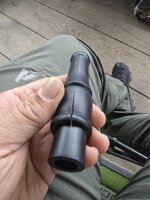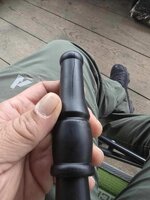So a couple of years ago I was still learning my way around turning, and decided I wanted to try making a deer call. Ordered the kit from Penn State and my stepdad had a scrap piece of ebony kicking around. I wasn't really considering the properties of the wood in relation to how the piece would be used; I thought the ebony would look and sound really nice for the call. Got it drilled out and turned, finished it with a very light coat of natural danish oil to try to protect the wood and gifted it to a good friend who is an avid hunter. He loves it, says it sounds great and he has successfully called in a number of nice deer with it.
Fast forward to yesterday, I got a text from him with some photos. The call is cracking with the grain in a couple of places. I am assuming that transition from warm to cold and/or dry to humid caused the wood to change shape to the point where it could not handle the stress and cracked. My question is this: Is it fixable and if so, what is the best way to do so? Also, is it possible to prevent further cracking? Or is this something to chalk up as a learning experience and move on?
Attached are some photos of both the completed piece and the cracks. Thanks in advance!
Fast forward to yesterday, I got a text from him with some photos. The call is cracking with the grain in a couple of places. I am assuming that transition from warm to cold and/or dry to humid caused the wood to change shape to the point where it could not handle the stress and cracked. My question is this: Is it fixable and if so, what is the best way to do so? Also, is it possible to prevent further cracking? Or is this something to chalk up as a learning experience and move on?
Attached are some photos of both the completed piece and the cracks. Thanks in advance!



